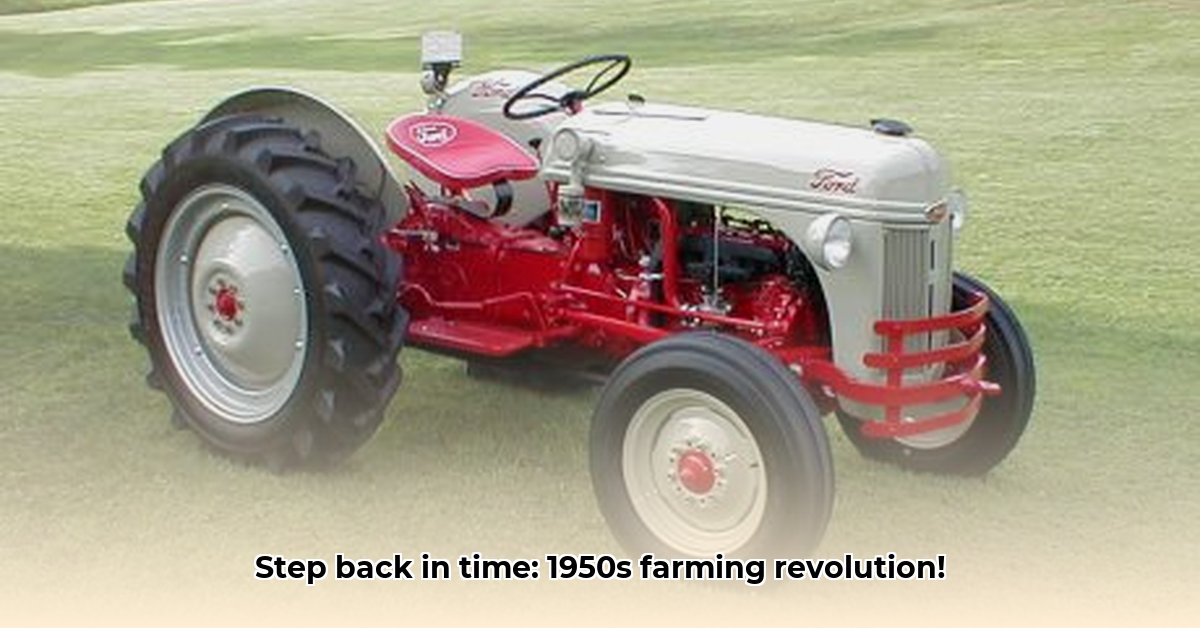
The 1950s: a decade of rock 'n' roll, drive-in movies, and a seismic shift in American agriculture. The horse-drawn plow was rapidly becoming a relic of the past, replaced by the powerful roar of the tractor. This era witnessed not just an increase in horsepower, but a complete transformation of farming practices, forever changing the lives of farmers and shaping the future of food production. This article delves into the fascinating world of 1950s tractors, exploring the major players, groundbreaking innovations, and the enduring legacy of these iconic machines. For more tractor history, check out this comprehensive resource.
Giants of the Field: The Major Tractor Manufacturers
Several manufacturers battled for dominance in the burgeoning tractor market. John Deere, already a respected name, cemented its position with innovative designs and a powerful brand image. International Harvester (IH) built rugged, dependable machines celebrated for their longevity and ability to withstand years of relentless work. Ford offered a more budget-friendly option, bringing the power of mechanization to smaller farms previously unable to afford such technology. Allis-Chalmers produced powerful tractors perfect for large-scale operations, while Massey Ferguson emerged as a strong contender with innovative designs and competitive pricing, quickly challenging the established giants. This intense competition ultimately benefited farmers, driving continuous advancements and providing a wider array of choices. Were these advancements equally beneficial across the board, or did certain farmers benefit disproportionately more than others?
More Than Just Horsepower: Technological Innovations
Beyond sheer power, several key innovations propelled 1950s tractors to the forefront of agricultural technology. The widespread adoption of diesel engines offered improved fuel efficiency and greater power compared to their gasoline counterparts. Hydraulic systems provided farmers with significantly enhanced control over implements, reducing physical strain and increasing efficiency. Tasks that once consumed days could now be completed in mere hours. This leap in technology directly translated to increased yields, allowing farmers to cultivate more land and dramatically improve their productivity. But what unforeseen consequences, if any, did this rapid mechanization have on rural communities?
Choosing the Right Tractor: A Farmer's Crucial Decision
Selecting a tractor in the 1950s was a significant investment, requiring careful consideration of several factors. Farm size and type of operation played crucial roles – a smaller farm might prioritize affordability and ease of use, potentially opting for a Ford tractor, while larger farms might favor the increased power and advanced features of an IH or Allis-Chalmers. Local terrain also influenced the decision; a tractor ideal for flat plains may be unsuitable for hilly regions. The decision required a careful balancing act: budget constraints, specific farming needs, and the challenges presented by the local environment. Did farmers have access to comprehensive information to guide their decisions, or was it a more intuitive process based on reputation and local experience?
The Enduring Legacy of 1950s Tractors
The impact of 1950s tractors extends far beyond their immediate contribution to agricultural productivity. They fundamentally reshaped farming practices, reducing the physically demanding labor that had defined generations of farmers. They contributed to significantly increased food production, feeding a rapidly growing nation. The legacy of these machines is palpable even today. Many meticulously restored vintage tractors stand as proud testaments to a bygone era, cherished by collectors and enthusiasts. These machines are not just old machinery, but living artifacts, powerfully illustrating the ingenuity of a period that marked a turning point in agricultural history. What might surprise contemporary audiences is the sheer craftsmanship and mechanical intricacy of these machines compared to more modern, electronically controlled tractors.
A Detailed Look at the Competition: Brand Comparison
The following table highlights the strengths and weaknesses of major manufacturers:
| Brand | Strengths | Weaknesses | Target Market |
|---|---|---|---|
| John Deere | Cutting-edge designs, innovative features, strong brand | Often higher initial cost | Wide range, including large and medium-sized farms |
| International Harvester | Robust, reliable machines, known for their longevity | Could sometimes lag behind in technological advancements | Large and medium-sized farms |
| Ford | Affordable, user-friendly, easy to maintain | Typically less powerful than other top brands | Smaller farms, budget-conscious farmers |
| Allis-Chalmers | High horsepower, ideal for large-scale operations | Less adaptable to diverse farming needs | Large farms, large-scale agricultural operations |
| Massey Ferguson | Innovative designs, competitive pricing, strong value | Newer to the market, still building brand recognition | Broad range of farms, appealing to price-conscious farmers |
How to Compare 1950s Tractor Models: A Step-by-Step Guide
Comparing 1950s John Deere, Ford, and International Harvester models requires a systematic approach:
- Define your needs: Clearly identify the types of tasks you will perform. (e.g., plowing, planting, harvesting)
- Research specifications: Compare horsepower, transmission type (manual, hydraulic), hydraulic system capabilities, and available features.
- Assess parts availability: Investigate the accessibility of parts and service in your region. A strong dealer network is crucial for minimizing downtime.
- Factor in cost: Consider both the initial purchase price and potential long-term maintenance and repair expenses.
- Consider historical reputation: Research the brand's reputation for reliability and durability. Reviews and historical data can provide valuable insights.
Key Considerations: Engine power significantly varied; design and features catered to different operational styles; transmission types and hydraulic systems directly impacted efficiency; parts availability was a key factor in uptime; pricing reflected both initial investment and long-term operational costs.
[1Classic Tractor News, "What Were the Top Brands of Tractors in the 1950s?", https://classictractornews.com/what-were-the-top-brands-of-tractors-in-the-1950s/]